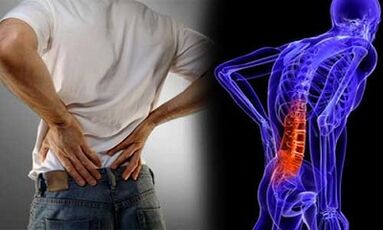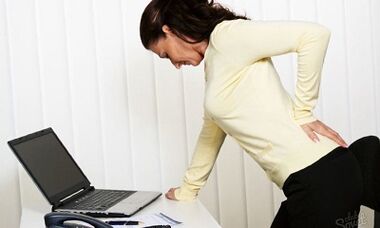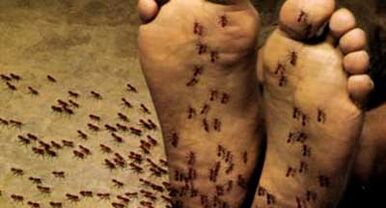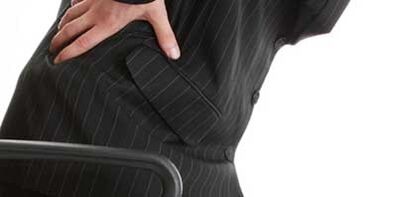You probably cannot find an adult just who did not know what is "lumbar osteochondrosis."On average, every healthy third person, from intermediate years, and sometimes more often, in his life he had an episode of acute low back pain, and every fifth to sixth indicates that such problems arise regularly and are even a "source" of the hospital leaf.
However, to explain in detail what exactly the violation occurred in the lower back, patients often cannot do so.Most of them have never been examined, and the treatment consisting of "injections", "ointments", massage sessions generally help for a period from several months to a year.
If "raises" a patient of this type and begins to ask about the diagnosis, then, after having suffered a little, he will declare that he is sick of "osteochondrosis."What does this disease mean, in relation to the lumbar column?
Osteochondrosis of the lumbar region: a disease or "life norm"?

First, he must say with authority: "Osteochondrosis" cannot hurt.And in any way it cannot be manifested, since this is the process of dystrophy and degeneration of the intervertebral discs, that is, cartilage, which consists of a pulpal nucleus and a fibrous ring.The intervertebral disc is cartilage and is designed to function as an "airbag" that absorbs the crash, softening vertical and angular accelerations: inhibition between the adjacent vertebrae.
As you know, the cartilage is devoid of nerve and vascular tissue, so the processes that "purely on the discs" simply cannot affect neighboring structures and do not appear in any way.A similar example in vertebroneurology is the hernias of the Shomorle, in which the hernial protuberance is reliably covered by the spongy bone tissue of the neighboring room.Intervertebral discs do not hurt.
Condrosis (suffix "-o" denotes an increase, increase), in this case, not quite correct.It does not happen during human life of growth and the increase in cartilage.Here with the fibrosis (cirrhosis) of the liver, it can be seen that the liver mesh structure began to develop, to the detriment of the function.
And with condrosis (or osteochondrosis), intervertebral discs only begin to change their configuration, under the influence of perennial loads.
They cause pressure on the neighboring vertebrae, because, according to Newton's law, each action to a static load gives birth exactly the same opposition or reaction of support.How does osteochondrosis develop and for what reasons happens?
The causes of the "lumbar osteochondrosis"
You can find signs of osteochondrosis of the lumbar region (more precisely, intervertebral discs) at an early age, especially with various violations of the musculoskeletal system.
They can be attributed, for example:
- congenital anomalies (different legs of length);
- various types of flat feet (longitudinal, transverse);
- Deformation of the spinal column (scoliosis);
- Spondylistz (sliding the lower lumbar vertebra of the sacral bone both forward and back).
All these diseases can cause or increase the shock load in the spine (for example, with flat feet, when the elasticity of the arc of the foot decreases), and with severe asymmetry of the spine, when the support function is systematically performed due to the load on the edge of the disc.
It was known that with the experiments it was discovered that the healthy and young cartilage, if they were given a uniform and static load throughout the surface, could support up to 2000 kg and even more for themselves.Of course, there is no such charge in everyday life, but it can increase to such values when exposed to the edge of the disc.
If the support area is 20 times smaller, and the disc will not be so healthy (for example, in old age), then exposure to 60-80 kg (for example, falling on ice to inclination to the side, with a load on the shoulders) can cause a destruction of the disc, which can be in the form of a protusion or hernia.
It is the appearance of protuberance or hernia that indicates that the album was deformed and even "dragged" from one or more sides.And around the album, as you know, there is no empty place.As soon as the disc begins to contact nerve roots, ligaments and neighboring muscles, the consequences of osteochondrosis are produced: reflection pain and muscle tonic syndromes that make the patient resort to a neurologist, manual therapist and masseuse.
Meanwhile, the discs have a normal shape and are wearing uniformly, without extreme loads, then the osteochondrosis of the lumbar column does not bother the patient no more than the abrasion of age of the usual age teeth, with which the criminals are well known.How do reflex pain syndromes manifest?
Symptoms and signs of complicated lumbar osteochondrosis

It has already noticed that "we raise" the bridges of the breeding ": the ordinary osteochondrosis is a completely inevitable process of ordinary aging of the" intervertebral elastic joints "in the type of" reasonable man ", since it moves vertically throughout life. And the" osteocondrosis "that patients with acute pain withdraws are a complicated condition.
We will begin, perhaps, with root compression signs.The signs of lumbar osteochondrosis, of course, are associated with pain, due to the segmental spine pressed by the disk.In addition to pain, sensitive disorders, trophic motors and vegetatives are possible.
Low's pain in osteochondrosis has the following characteristics:
1) Edge pain.It is secondary, and proceeds in accordance with the type of neuralgia, when the swollen nerve column reacts very "violently" to a brain shock.
The pain is acute, sudden, shooting, drilling the lower back, possibly giving up.The pain appears and instantly intensifies, so it is called "lumbago" or "background".It is a "shutter" that makes a person "face a Naracan", since any movement leads to greater pain.
In addition, the pain intensifies in the slightest cough, sneezing, tensions, laughs, any situation in which a swollen column is treated.
In the event that the column is part of the sciatic nerve, the pain "triggers" through the buttock towards the popliteal pit and below, and this is called "lumbar algia."
2) Muscle pain.Near the nerve column there are great muscle solids.Often, in spring and autumn "they stand up", and swell, they become dense.Venous exit is difficult for them, and they themselves are a source of pain.
This pain is sore, constant and not so hard.On the contrary, it intensifies not only with an acute movement, but also with a prolonged one in a monotonous position (deterioration of the blood supply).
- Sometimes, such of myofascial syndrome occurs after the exacerbation of protuberance or hernia, when a strong "hook" of the hernia "massages" the muscles and ligaments for a long time.
3) Motor disorders.Since the album can squeeze not only a sensitive spine, but also a spine, it is possible to develop peripheral paresis or even paralysis.With different levels of damage, the appearance of weakness in the legs is possible (for example, weakness when climbing the stairs on the one hand), weakness in the foot, which leads to the deteriorated march.
There is muscle hypootrophy, one leg is "losing weight."Such a purely motor and painless disorder is rare and, which remains unnoticed, can cause disability.

4) Sensitive violations.They arise along with pain, there are often even after the end of pain, instead of pain.They are manifested by numbness, a decrease in the sensitivity of the skin of the legs by the type of "stripes", in the form of vertical stripes, a feeling of "chicken skin cats" on the fingers and feet.
- Sometimes, with damage to vegetative fibers, symptoms are combined with hyperhidrosis, skin cooling, hair growth and nails.
These are the most general signs of complicated lumbar osteochondrosis that exist in the lumbar region.There are separate syndromes, for example, damage to the external skin of the thigh, or damage to the horse tail, epiconus, pure radicalis or pear -shaped muscle syndrome, but even its brief description will take too much time.
For patients, the above is sufficient, the main signs to register in a neurologist.How can "eliminate exacerbation with your own hands"?How to treat the lumbar osteochondrosis of the house?
What to do during the exacerbation of lumbar osteochondrosis?
The basis of all treatment is ethiotropic therapy (elimination of the cause) and pathogenetic treatment (which affects the mechanisms of the disease).The symptomatic therapy guides it.
With vertebrogen pains (caused by column problems), things are like this:
- The elimination of the cause is the elimination of pressure by bump, a hernia or a spasmous muscle on a nerve root;
- The impact on mechanisms is the elimination of muscle spasm, the restoration of venous flow in the muscles, the elimination of the edema of the nerve column and the fight against inflammation;
- The elimination of symptoms (the fight against pain, numbness, the limitation of mobility) is carried out by returning to paragraph No. 2, since the elimination of edema and inflammation, for example, will return mobility and relieve pain.
Get rid of protuberance and hernia
As a rule, it does not begin to treat acute back pain.Almost always at the beginning they stop pain syndrome, then, after the massage and treatment sessions of the manual therapist, all symptoms disappear and the operation is not required.
The question of surgical intervention arises with the progression of weakness in the foot and with severe and unconscious pain in 2 months.In addition, the operation is required when compressing the central channel at high levels in which the spinal cord or the "horse tail" is located.
Lumbar osteochondrosis treatment, drugs
The treatment of lumbar osteochondrosis and its complications foresees the following measures.In the sharp phase (first day - two):
- To reduce muscle edema and spine, a diet without sleep and the limitation of the amount of liquid used is indicated.You can even give a tablet of a slight diuretic drug that saves potassium.
- The use of a rigid medium orthopedic corset is shown, which saves the muscles of excessive movement.
- From the first days, the ointments containing NSAIDs, the application of plasters, for example, "pepper" are shown.
- You cannot heat your back in the sharp phase.With the increase in inflammation, edema increases.Therefore, all types of heating pads are prohibited.It can heat, take your own warmth (wool belt, heating ointments), which are not added from the outside, but, on the contrary, it is removed from the depths.
- In the acute phase for the osteochondrosis of the lumbar region, a short -term treatment with intramuscular "injections" of the NSI and the muscle relaxants can be carried out.This will help stop the edema of nerve tissue, eliminate inflammation and normalize muscle tone.
In the subacute period, after overcoming maximum pain, "injections" should no longer be taken, and attention must be provided to the restorative media, for example, modern vitamins preparations of the "B" group.They effectively restore deteriorated sensitivity, reduce numbness and paresthesia.
The physiotherapeutic measures continue, the time comes to perform exercise therapy for the osteochondrosis of the lumbar column.Its task is to normalize blood circulation and muscle tone, when edema and inflammation have already been removed, and muscle spasm was not yet completely resolved.
Exercises for lumbar osteochondrosis of the column must be performed after a common warm light, in the "warm muscles."
The main therapeutic factor is movement, not the degree of muscle contraction.Therefore, to avoid relapse, the use of loads is not allowed, a gymnastic carpet and a gymnastic stick are used.With your help, you can effectively restore the volume of movements.
The rubbing of ointments, the use of Iplicator Kuznetsov continues.Swimming, underwater massage, Sharko shower are shown.It is in the amounted exacerbation stage that medications for home magnetotherapy and physiotherapy are shown.
In general, the treatment does not take more than a week, but in some cases, osteochondrosis can manifest itself with symptoms so dangerous that the operation may be necessary and urgent.
Complications of the osteochondrosis of the lumbar column

It is, in the first place, about the condition when the hernia of the disc became an independent fragment and, having penetrated the central channel, formed a free kidnapping.There, you can press the nerves of the horse of the horse, and suddenly (right in the gym, after an episode of acute pain) develops a strong weakness or leg paralysis, numbness of the perineum.
After a few minutes, brutal pain appears in the legs, and then, a delay reflex in the urine, or the appearance of incontinence, develops impotence.This arose from the horse's tail syndrome, as a complication of an album hernia.In this case, urgent intervention, kidnapping extraction and restoration of the function of the horse's tail with its decompression is required.
However, most of the time, other complications arise.With age, multiple hernias and protrusion occur, the osteoporosis of the vertebrae appears, and mobility simply decreases and the risk of acute back pain increases.Such patients will surely "take a disease license" a couple of times a year, and are often treated in sanatoriums.
Treatment forecast
The osteochondrosis of the lumbar column, the symptoms and treatment that we dismantle higher, as we understood for ourselves, is mostly a disease, but simply by a manifestation of inevitable aging and "contraction" premature of intervertebral discs.
Can humanity be completely saved from lumbar osteochondrosis?This response can be answered affirmative, but we will have to master a different movement style: all our lives to make four legs or, like Ichtyander, float towards the depths of the ocean, constantly moving in the water from childhood.It is then that the axial and static load on the intervertebral discs will disappear, and with it the signs of "condrosis" will disappear.But another problem will arise: in the water, such a powerful design will become simply unnecessary and will begin to change until it disappears, or will not decrease significantly.
As for the personal and individual forecast for osteochondrosis, it all depends on the moment a person "decided to take the mind."If at this time there is no pronounced destruction of the intervertebral discs, protuberances, hernias and deformations, then, subject to a healthy lifestyle and hygiene, physical activity cannot be known by the age of the lower back.
In the same case, when there is already a "hot point" in the area of the lumbar region, for example, in the form of hernia, which periodically squeezes the nerve column, then a person must especially take care of the uncomfortable tours, the physical exercise, the incorrect survey of the severity and seasonal hypothermia, which generally causes an exacerbation of osteochondros of the spine.



































